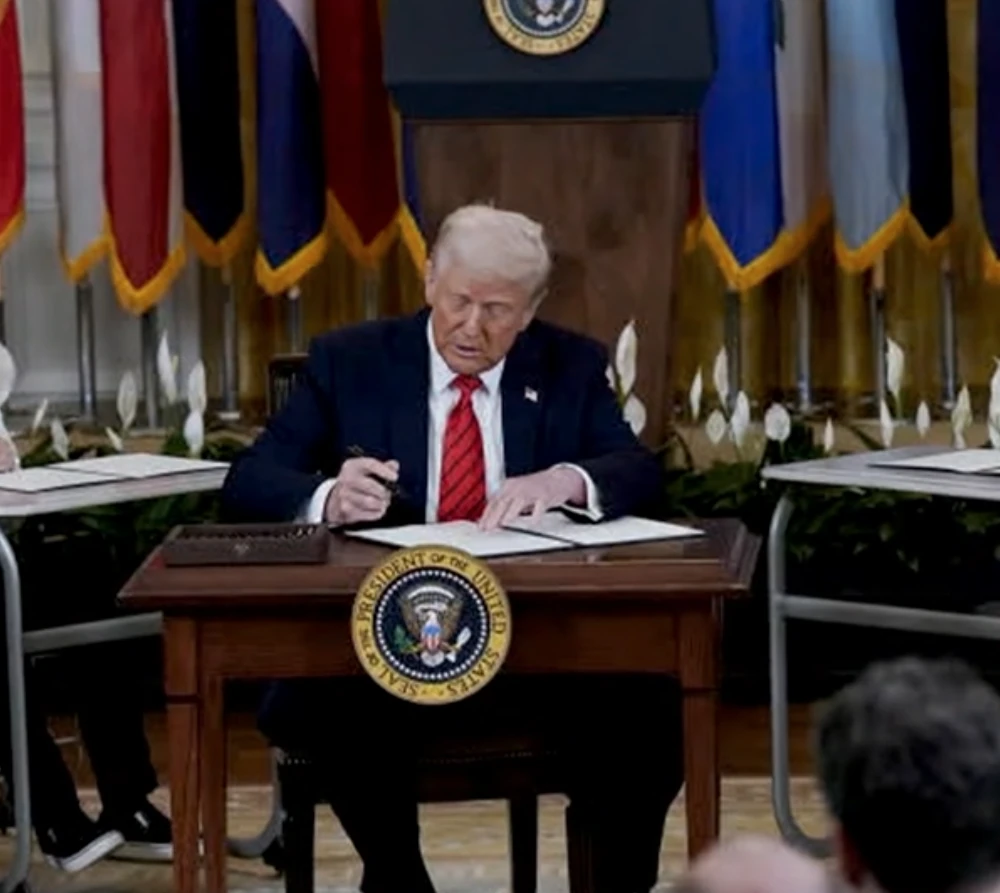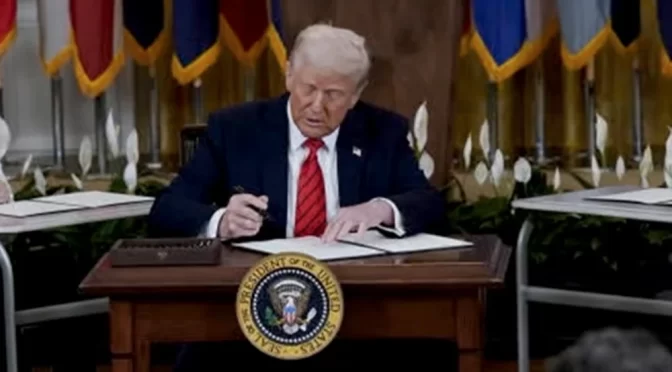- 1.69 Tn dept of Student loans for Higher Ed. – 43 Mn people- Then SOLD to FOR PROFIT, HIGH INTEREST Companies like Sallie Mae.
- Congress has to vote in favor for the order to pass.
- Upon dissolved, Federal money has to go U.S. States as block grants.
- Department of Education doesn’t educate anyone.
- Doesn’t hire teachers
- Doesn’t establish curriculum
- Doesn’t hire school boards or superintendents
- Trumps goal is to FUND States directly
NOT EFFECTED
- Federal Student Loans
- Pell Grants – federal awards based on financial need
- Students of disabilities or TITLE 1 funding “Title I of the ESEA supplements State and local funding for low-achieving children, especially in high-poverty schools”
- Does NOT eliminate federal education laws
- Elementary and Secondary Education Act, which provides federal funding for K-12 schools and the Individuals with Disabilities Education Act, which ensures students with disabilities are offered a free education tailored to their needs.
- “Title I of the ESEA supplements State and local funding for low-achieving children, especially in high-poverty schools” Title I Improving The Academic Achievement of The Disadvantaged
- Title I Achievement-Focused Monitoring

Local Cities and States to Fund Schools
Your local cities and states are stepping up to fund schools and education, thanks to a bold move to “return authority over education to the States and local communities while ensuring the effective and uninterrupted delivery of services, programs, and benefits on which Americans rely,” as stated by McMahon, a key figure in this shift. The federal Department of Education is on its way out—slashed by nearly 50% already and set to dissolve entirely. Here’s what’s happening, why it matters, and what it means for your kids.
The Big Shift: Dissolving the Department of Education
On March 20, 2025, President Donald J. Trump signed an executive order titled Improving Education Outcomes by Empowering Parents, States, and Communities. It’s a game-changer, aiming to dismantle the Department of Education and hand its powers back to states and local communities. But don’t worry—“dissolving the department doesn’t necessarily eliminate the federal education laws that states must follow,” says Weade James, senior director of K-12 education policy for the Center for American Progress. The rules still stand; only the bureaucracy’s getting the axe.
The department’s already shrinking. On March 11, 2025, it announced a massive workforce cut—nearly 50%, dropping from 4,133 employees to 2,183. Starting March 21, 2025 (today!), affected workers go on administrative leave with full pay and benefits until June 9, 2025. About 600 of those leaving took voluntary resignation or retirement offers. “A 50 percent workforce reduction is sizeable and could very well be a good thing,” wrote Neal McCluskey, director of the Center for Educational Freedom at the Cato Institute, a libertarian think tank. “We don’t know how many people are actually needed to execute US ED’s jobs, and it’s time to find out if it’s been a bloated bureaucracy all along.”
What Happens to the Money?
Once the department’s dissolved, federal education funds won’t vanish—they’ll flow to U.S. states as block grants. “What that means is (school) districts will be responsible for using that money however they choose, and hopefully it is the right way to serve students with disabilities,” explains Weade James. Take Title I, for example: it provides supplemental financial assistance to school districts for children from low-income families. Its purpose? To give all kids a “significant opportunity to receive a fair, equitable, and high-quality education, and to close educational achievement gaps” by allocating federal funds for education programs and services. That mission doesn’t die—it just shifts to local control.
Student loans and Pell grants? They’re sticking around too. “The Department of Education will be much smaller than it is today,” said Leavitt, adding that the executive order directed McMahon “to greatly minimize the agency. So when it comes to student loans and Pell grants, those will still be run out of the Department of Education.” A leaner operation, not a total shutdown.
Why Now? The Case for Closure
The executive order lays it out plain: the federal education experiment’s failed. “Our Nation’s bright future relies on empowered families, engaged communities, and excellent educational opportunities for every child,” it reads. “Unfortunately, the experiment of controlling American education through Federal programs and dollars—and the unaccountable bureaucracy those programs and dollars support—has plainly failed our children, our teachers, and our families.”
The numbers back it up. Taxpayers shelled out $200 billion at the federal level on schools during the COVID-19 pandemic, plus over $60 billion annually for federal school funding. Yet, this year’s National Assessment of Educational Progress showed grim results: 70% of 8th graders were below proficient in reading, and 72% in math. The Department of Education, created in 1979 under President Jimmy Carter after pressure from teachers’ unions, isn’t educating anyone—it’s got a PR office with over 80 staffers costing $10 million a year. “The Federal education bureaucracy is not working,” the order declares.
Higher ed’s a mess too. The department manages a $1.6 trillion student loan debt portfolio—roughly the size of Wells Fargo, a major bank with over 200,000 employees. The Office of Federal Student Aid? Just 1,500 staff. “The Department of Education is not a bank, and it must return bank functions to an entity equipped to serve America’s students,” the order insists.

https://pixabay.com/illustrations/money-savings-finance-costs-budget-891357/ Tumisu 03-21-2025 – Quoted
EXECUTIVE ORDER READS AS FOLLOWS:
“Improving Education Outcomes by Empowering Parents, States, and Communities
Executive Orders
March 20, 2025
By the authority vested in me as President by the Constitution and the laws of the United States of America, and to enable parents, teachers, and communities to best ensure student success, it is hereby ordered:
Section 1. Purpose and Policy. Our Nation’s bright future relies on empowered families, engaged communities, and excellent educational opportunities for every child. Unfortunately, the experiment of controlling American education through Federal programs and dollars — and the unaccountable bureaucracy those programs and dollars support — has plainly failed our children, our teachers, and our families.
Taxpayers spent around $200 billion at the Federal level on schools during the COVID-19 pandemic, on top of the more than $60 billion they spend annually on Federal school funding. This money is largely distributed by one of the newest Cabinet agencies, the Department of Education, which has existed for less than one fifth of our Nation’s history. The Congress created the Department of Education in 1979 at the urging of President Jimmy Carter, who received a first-ever Presidential endorsement from the country’s largest teachers’ union shortly after pledging to the union his support for a separate Department of Education. Since then, the Department of Education has entrenched the education bureaucracy and sought to convince America that Federal control over education is beneficial. While the Department of Education does not educate anyone, it maintains a public relations office that includes over 80 staffers at a cost of more than $10 million per year.
Closing the Department of Education would provide children and their families the opportunity to escape a system that is failing them. Today, American reading and math scores are near historical lows. This year’s National Assessment of Educational Progress showed that 70 percent of 8th graders were below proficient in reading, and 72 percent were below proficient in math. The Federal education bureaucracy is not working.
Closure of the Department of Education would drastically improve program implementation in higher education. The Department of Education currently manages a student loan debt portfolio of more than $1.6 trillion. This means the Federal student aid program is roughly the size of one of the Nation’s largest banks, Wells Fargo. But although Wells Fargo has more than 200,000 employees, the Department of Education has fewer than 1,500 in its Office of Federal Student Aid. The Department of Education is not a bank, and it must return bank functions to an entity equipped to serve America’s students.
Ultimately, the Department of Education’s main functions can, and should, be returned to the States.
Sec. 2. Closing the Department of Education and Returning Authority to the States. (a) The Secretary of Education shall, to the maximum extent appropriate and permitted by law, take all necessary steps to facilitate the closure of the Department of Education and return authority over education to the States and local communities while ensuring the effective and uninterrupted delivery of services, programs, and benefits on which Americans rely.
(b) Consistent with the Department of Education’s authorities, the Secretary of Education shall ensure that the allocation of any Federal Department of Education funds is subject to rigorous compliance with Federal law and Administration policy, including the requirement that any program or activity receiving Federal assistance terminate illegal discrimination obscured under the label “diversity, equity, and inclusion” or similar terms and programs promoting gender ideology.
Sec. 3. General Provisions. (a) Nothing in this order shall be construed to impair or otherwise affect:
(i) the authority granted by law to an executive department or agency, or the head thereof; or
(ii) the functions of the Director of the Office of Management and Budget relating to budgetary, administrative, or legislative proposals.
(b) This order shall be implemented consistent with applicable law and subject to the availability of appropriations.
(c) This order is not intended to, and does not, create any right or benefit, substantive or procedural, enforceable at law or in equity by any party against the United States, its departments, agencies, or entities, its officers, employees, or agents, or any other person.
DONALD J. TRUMP
THE WHITE HOUSE,
March 20, 2025. “
Sources
- Title I Information: U.S. Department of Education, https://www.ed.gov/laws-and-policy/laws-preschool-grade-12-education/title-I
- National Assessment of Educational Progress Data: National Center for Education Statistics, https://nces.ed.gov/fastfacts/display.asp?id=158
- Weade James Quotes: Attributed to Weade James, senior director of K-12 education policy at the Center for American Progress, as provided in the original text.
- Neal McCluskey Quote: Attributed to Neal McCluskey, director of the Center for Educational Freedom at the Cato Institute, as provided in the original text.
- Executive Order: Full text as provided by the author, signed by President Donald J. Trump, March 20, 2025.
- https://pixabay.com/illustrations/money-savings-finance-costs-budget-891357/ Tumisu 03-21-2025 – Quoted
Author Ryan Bridglal, 03-21-2025
#featured #bridgenewzcom #bridgenewz #breakingnews #breaking #news #businessnews Ttrump #donaldtrump #executiveorder #executive #order #DOE #Education #Cuts #Budget #political #finance #law
